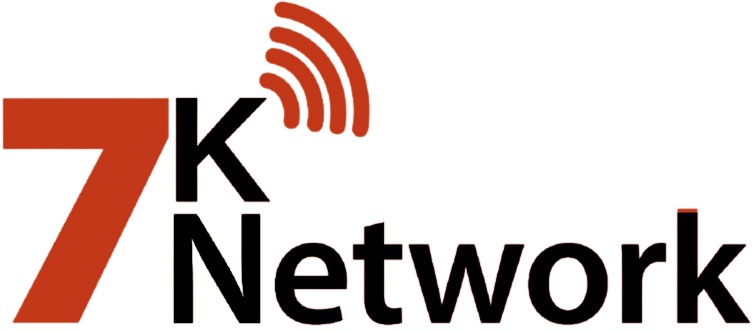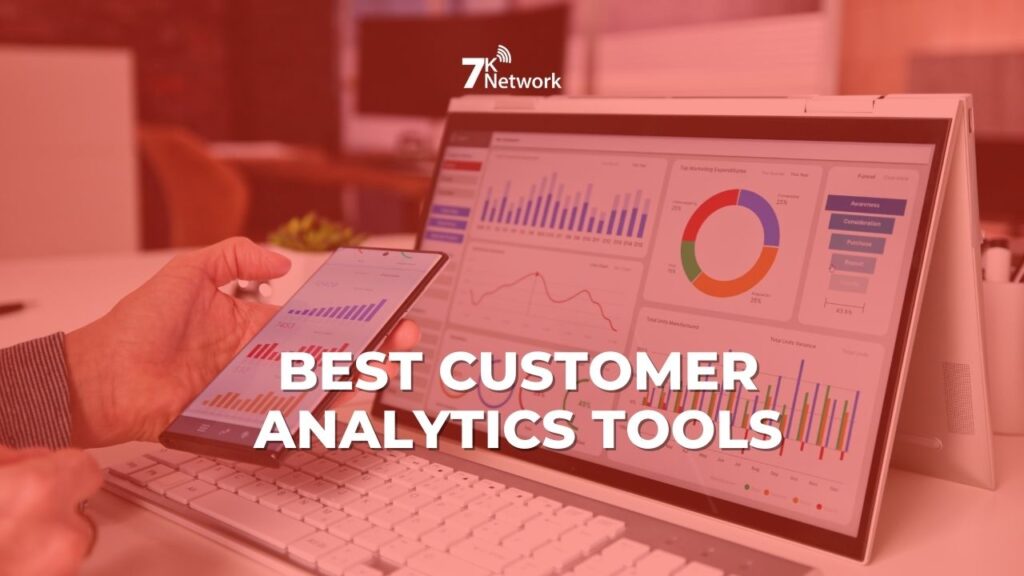Businesses need to use customer analytics tools to know how their buyers act and what they like or do with their money. These systems use information to create helpful business results while giving better customer service and marketing plans and bringing in more money. When you use analytics tools that visualize data along with prediction and segmenting tools you give your business better chances at data-based decision making.
Companies can find different types of solutions that suit their requirements whether they need a CRM system or advanced analytics platform. This article examines 15 leading customer analytics tools and explains their functionality and advantages while discussing their impact on audience comprehension and connection. The tool range works for both tiny new companies and large corporate entities.
What is a Customer Analytics Tool?
The Customer Analytics Tool collects and studies customer interaction data to help companies discover what their customers want and how they behave. These tools show companies the entire path customers take to interact with products and services letting businesses personalize marketing to better serve customers and keep them coming back.
Customer analytics tools use AI and machine learning to find patterns in data then divide groups of customers and forecast future actions. Companies apply analyzed data to make better business choices and create customer-tailored products while growing their profits.
Businesses examine complete purchase data along with website clicks paired with social media habits together with results from company surveys.
How Customer Analytics Tools Drive Business Growth
- Increased Customer Knowledge: Study customers to understand what they want then create product features that match their expectations.
- Improved Personalization: Show customers experiences that match their personal interests through targeted marketing plans.
- Customer Trust: Study your existing customer loss data to locate at-risk customers so you can develop plans for keeping them.
- Better Decision-Making: Base your business choices on data results to run operations better.
- Higher Revenue Generation: Achieve greater sales results through personalized promotions that find new customers while selling them more of our best products.
- Optimised Customer Experience: Our team finds all user problems in the customer path to simplify how users interact with our products and services.
- Competitive Advantage: Your market advantage comes from using insights to react faster to customer needs and industry changes.
- Cost Efficiency: Put your resources into serving the most valuable customer types and running proven marketing efforts.
- Development of New Products and Services: Find customer needs that go unserved then create products that answer customer demands.
- Stronger Brand Loyalty: Show customers your trustworthiness through constant delivery of value while recognizing their needs.
List of Best 15 Customer Analytics Tools
1. Google Analytics
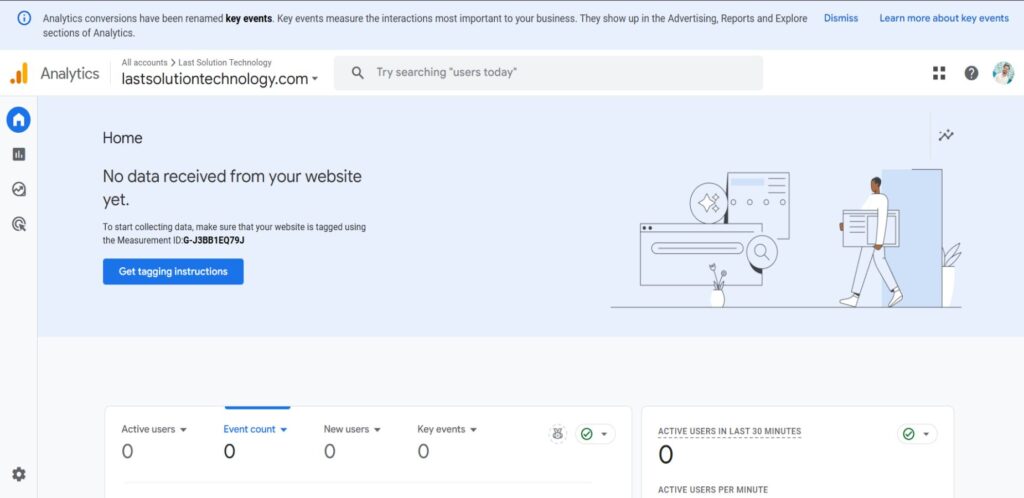
Google Analytics Services provides analysis on a web traffic reporting scale to websites for the sake of a business and its site owner. Analyzing the users, their origin in coming in and how these lead to actual sales are major issues taken into account so the necessary improvements in strategies on marketing in terms of being online may be established and realized.
With the integration of Google Ads and other Google tools, it helps boost performance in marketing. On the other hand, it’s user-friendly but may require learning some advanced features for beginners.
Features:
- Tracks website traffic and user behavior.
- Provides real-time reporting.
- Conversion tracking and goal setting.
- Integration with Google Ads.
- Audience segmentation and demographics.
Pros:
- Free and widely accessible.
- Easy integration with Google tools.
Cons:
- Complex interface for beginners.
- Limited cross-device tracking.
Website: https://analytics.google.com
2. Mixpanel
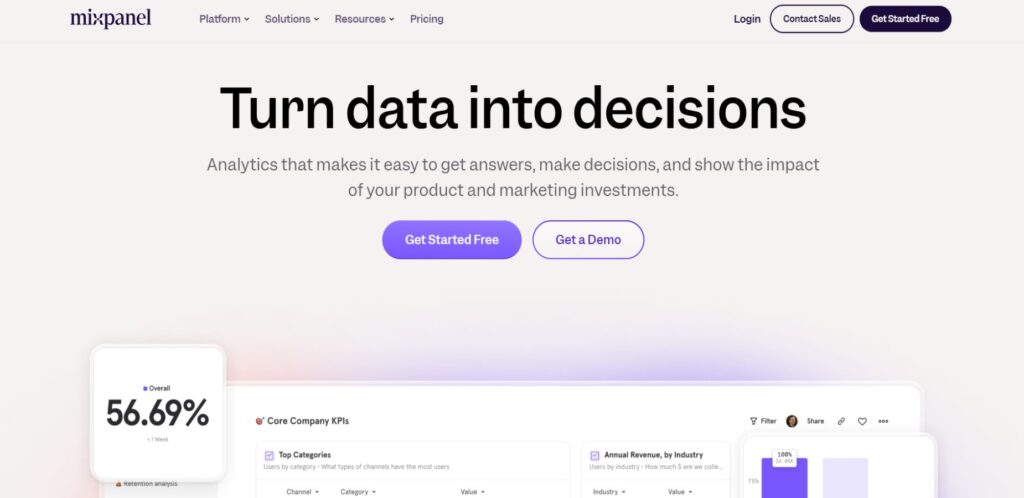
Mixpanel is an advanced analytics, which provides insights into product performance and usage in web or mobile applications. Based on events, funnels, and user journey analysis, businesses learn what their users have been doing using the apps. Mixpanel offers features like the collection of real-time data, cohorts, A/B testing, and advanced segmentation features.
It aims to drive business improvements in users’ retention levels, conversion, and optimization of data for product improvement. It is an intuitive interface and analytics tool that would prove to be quite a powerful business decision-making tool, but it does come at a steep price, which might not be suitable for small businesses.
Features:
- Tracks user interactions and events.
- Funnel analysis and cohort analysis.
- A/B testing for optimized performance.
- Real-time user data updates.
- Detailed segmentation capabilities.
Pros:
- Highly customizable and robust.
- Great for mobile and web apps.
Cons:
- Expensive for small businesses.
- Steeper learning curve.
Website: https://mixpanel.com
3. Kissmetrics
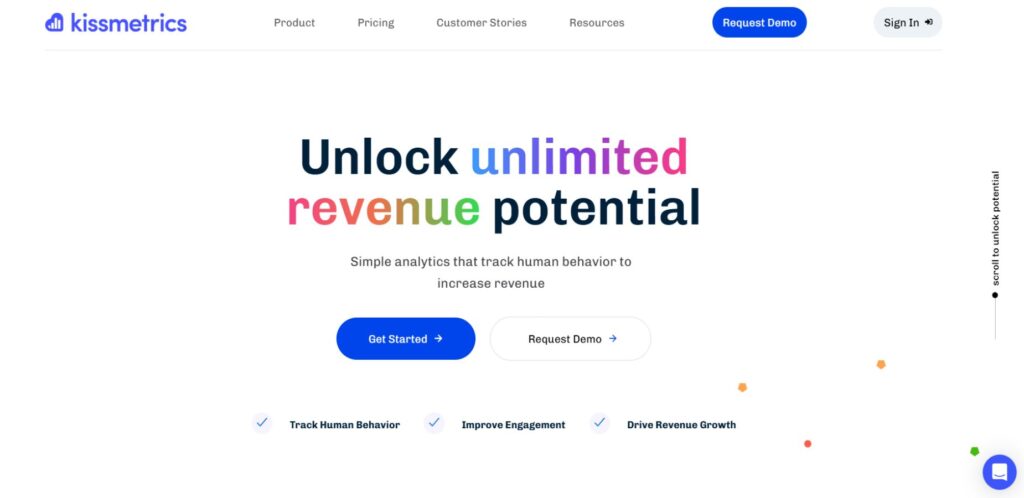
Kissmetrics is an analytics software that gives businesses insight into their customers’ behaviors through actionable data. It tracks many customer journeys, including multiple devices and touchpoints, focused on every individual customer interaction. Kissmetrics helps companies strategize better through marketing, maximize user experience, and increase retention rates by including detailed cohort analysis, conversion tracking, and event tracking.
Its powerful capabilities in segmentation allow businesses to target specific customer groups precisely. While Kissmetrics is known for its deep customer insights and user retention tools, its pricing can be a barrier for smaller businesses, and it may require a learning curve for new users.
Features:
- User behavior tracking across devices.
- Funnel and cohort analysis.
- Retention tracking and customer segmentation.
- A/B testing for optimizing experiences.
- Integrates with other marketing tools.
Pros:
- Focuses on customer lifecycle insights.
- Excellent for user retention strategies.
Cons:
- Pricing may be a barrier for small businesses.
- Learning curve for beginners.
Website: https://www.kissmetrics.io
4. Amplitude
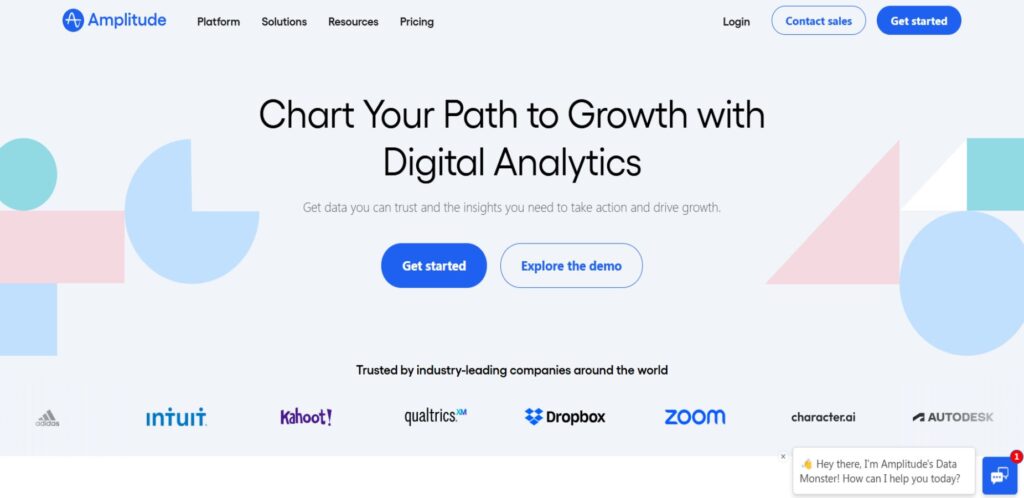
It is a product analytics platform that lets businesses track and analyze user behavior with the ultimate goal of optimizing product experiences. Its benefits are such that it helps businesses dig deeper into how users interact with digital products and, through various strategies, enables businesses to make better decisions and retain more users.
The major features include cohort analysis, funnel tracking, user segmentation, and event tracking. Amplitude enables businesses to follow through on important key performance indicators in real time even as the companies refine the products based on the trend. It is extremely helpful to product teams and data-driven companies. It might be very confusing for people with new exposure, and pricing could be on the higher end for small companies.
Features:
- Tracks user behavior and interactions.
- Product analytics and cohort analysis.
- Real-time data updates.
- A/B testing and event tracking.
- Deep data segmentation for insights.
Pros:
- Powerful for product-driven businesses.
- Easy-to-use interface.
Cons:
- Expensive for smaller companies.
- Some advanced features require technical knowledge.
Website: https://www.amplitude.com
5. Woopra
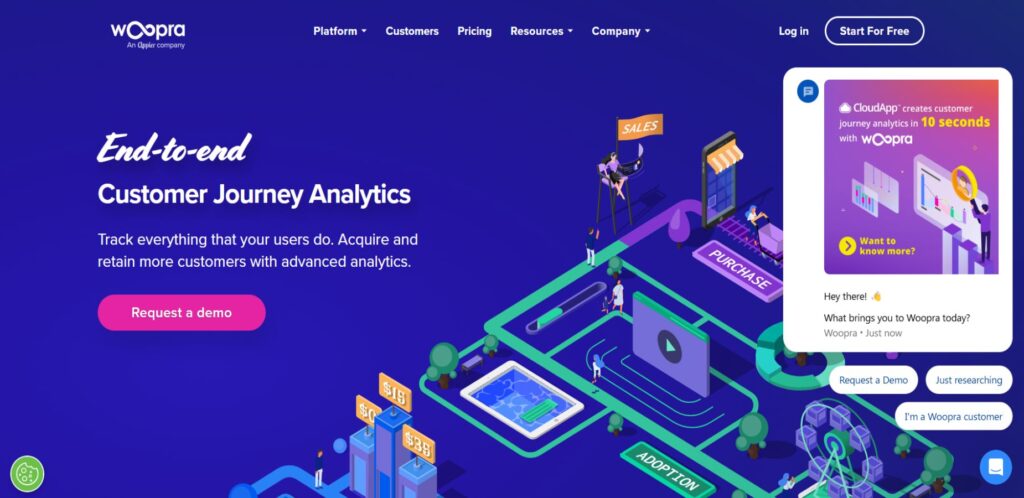
Woopra is a customer journey analytics platform used to track all real-time activities across websites as well as their mobile applications and gives insights that enable businesses regarding the way through which users intermingle within their products and services, helps improve customer experiences and drives them toward engagement and activity.
A few of the features include user segmentation, tracking in real-time, funnel, cohort analysis and customized reports. The system will allow for easy extension into CRM systems and other marketing tools by streaming customer data seamlessly. In terms of customer retention and journey analysis, Woopra can be effective, although it might be challenging for new users to navigate, and small businesses may not find the pricing reliable.
Features:
- Tracks real-time customer activity.
- Provides funnel analysis and cohort analysis.
- Customizable dashboards.
- Integration with CRM and other marketing tools.
- In-depth segmentation and retention metrics.
Pros:
- Real-time data tracking and insights.
- Easy integration with other platforms.
Cons:
- Limited advanced features for larger enterprises.
- Can be complex for new users.
Website: https://www.woopra.com
6. Brandwatch
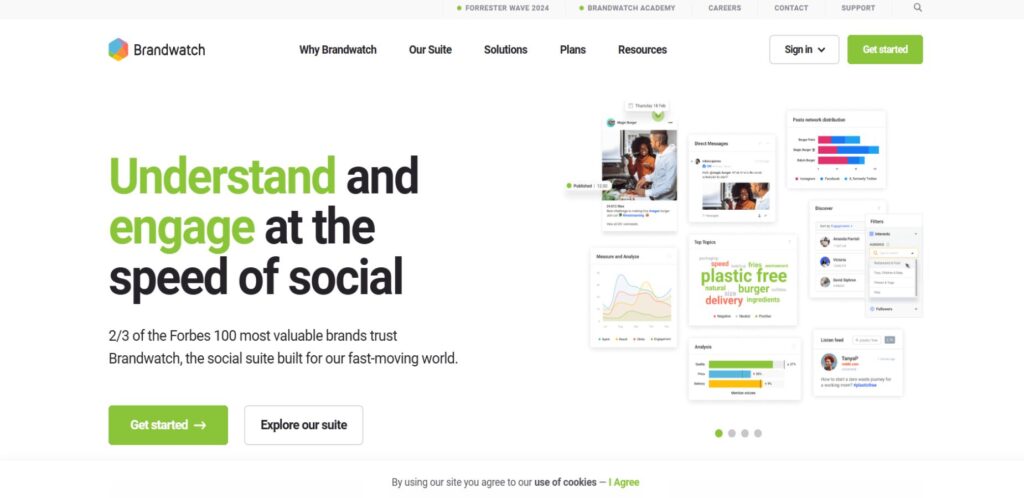
Brandwatch is the leading social media monitoring and analytics platform providing businesses with ways to monitor what’s being talked about online, such as brand mentions and customer sentiments. It brings insights from social media, blogs, forums, and news websites, meaning that brands can keep track of their reputation and be in the know about what’s trending.
The main features of the platform include sentiment analysis, competitive benchmarking, trend tracking, influencer identification, and reporting. Brandwatch assists in sharpening business marketing strategy, improving customer engagement, and helping the brand be more recognizable. However, for small companies, its price might be quite high, and some time might pass before mastering all the advanced features of the platform.
Features:
- Monitors brand mentions across social media.
- Sentiment analysis and trend tracking.
- Competitor benchmarking and market analysis.
- Real-time alerts for brand mentions.
- Visual reporting and dashboards.
Pros:
- Comprehensive social listening and analytics.
- Deep sentiment analysis.
Cons:
- Pricing may be high for smaller businesses.
- Requires time to master advanced features.
Website: https://www.brandwatch.com
7. Zendesk
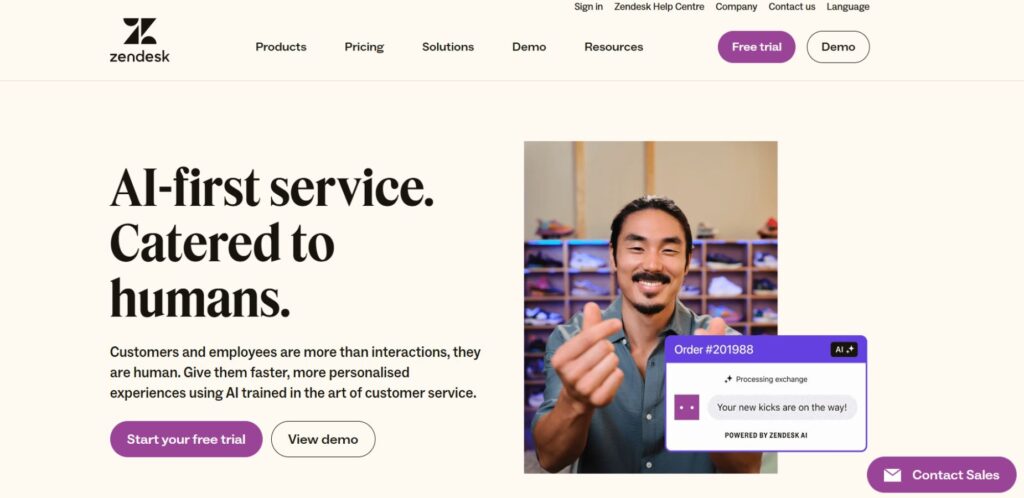
Zendesk is a customer service company, which offers businesses tools to manage and improve customer support across various channels such as emails, chats, phone calls, and social media. The company provides a comprehensive suite of features that powers ticketing, live chat, knowledge base creation, and reporting, designed to streamline workflows around support for companies.
Zendesk allows teams to automate tasks, prioritize requests, and deliver personalized customer service. Its intuitive interface and integrations with other tools make it popular among businesses of all sizes. However, Zendesk’s pricing can be high for small businesses and advanced features may require a learning curve.
Features:
- Multi-channel support (email, chat, phone).
- Automated ticket routing and workflows.
- Knowledge base and self-service options.
- Reporting and analytics for support teams.
- Integrates with third-party applications.
Pros:
- Easy-to-use interface.
- Strong customer support features.
Cons:
- Expensive for small businesses.
- Limited customization in some plans.
Website: https://www.zendesk.com
8. Adobe Experience Cloud
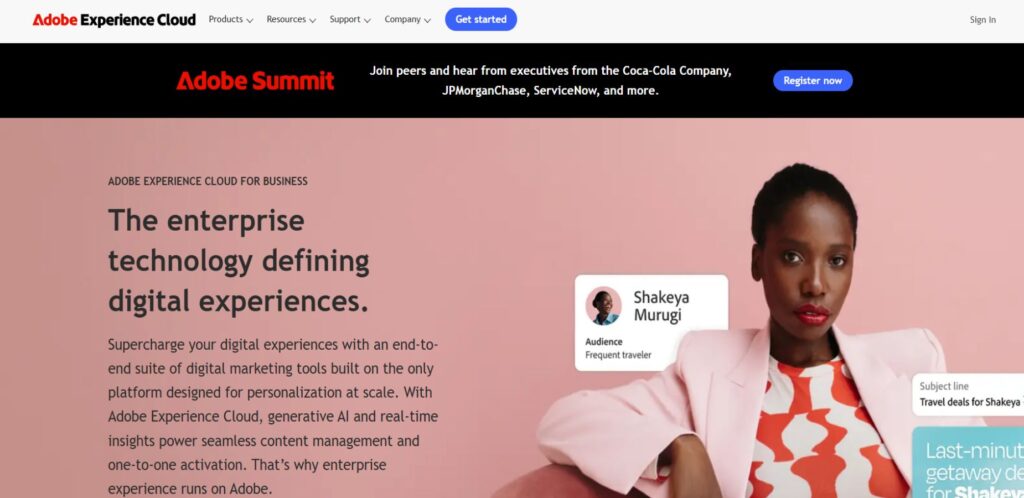
The Adobe suite of solutions for marketing, advertising, analytics, and e-commerce allows companies to offer the most consistent, personalized experiences on all types of touchpoints across their customer interfaces. Under one umbrella lie many of these different Adobe solutions, including but not limited to Adobe Analytics, Adobe Target, and Adobe Campaign, all under one roof to help companies better manage their digital activities.
Adobe provides analytics, content creation, mapping of the customer journey, and campaign management capabilities. It’s particularly useful for enterprises that look to enhance their digital presence and improve customer engagement. However, it can be pricey for smaller businesses, and it has a pretty steep learning curve.
Features:
- Multi-channel marketing automation.
- Advanced analytics and data insights.
- Personalization and targeting capabilities.
- A/B testing and optimization tools.
- Integration with other Adobe tools.
Pros:
- Comprehensive suite for digital marketing.
- Excellent for large enterprises.
Cons:
- Expensive for small businesses.
- Complex for beginners to implement.
Website: https://www.adobe.com/experience-cloud
9. Tableau
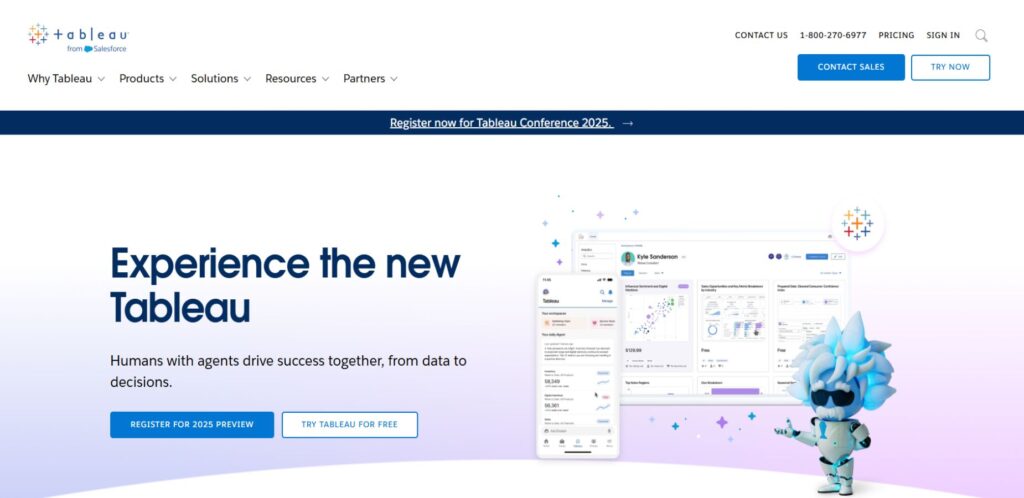
Tableau is a very powerful tool for data visualization and business intelligence in which data can be analyzed with the help of some interactive and intuitive graphical interfaces for its visualization. It does not require coding on dashboards, reports, or charts, facilitates drag-and-drop functionality, creates a real-time connection to data sources, supports analytics and advanced analytics capability, and data blending capability from multiple sources of data.
Tableau is largely utilized for business decisions, giving firms the power to find patterns and trends hidden within large sets of data. Nonetheless, the price range of Tableau can be pricey and often difficult to use. It best applies to groups with heavy-use requirements for a quality data visualization platform.
Features:
- Drag-and-drop data visualization tools.
- Real-time analytics and insights.
- Integration with multiple data sources.
- Customizable dashboards and reports.
- Mobile and desktop support for access anywhere.
Pros:
- Highly visual and intuitive interface.
- Excellent for big data analysis.
Cons:
- Can be costly for small businesses.
- Steep learning curve for beginners.
Website: https://www.tableau.com
10. CleverTap
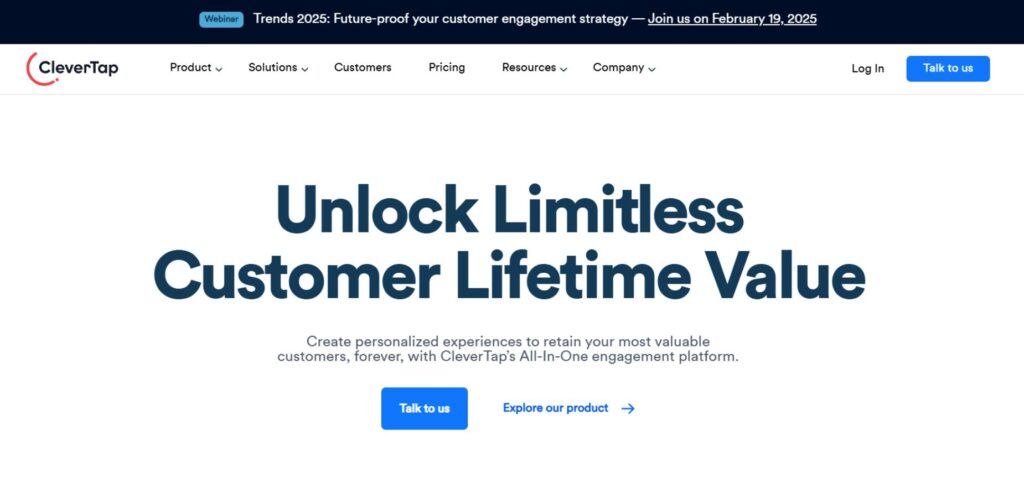
CleverTap is the customer retention and engagement platform that allows businesses to uplift user experience across mobile apps, websites, and other digital media. Artificial intelligence and machine learning power it to deliver personalized messaging and automation to create targeted campaigns based on user behavior and demographics.
Some key features include real-time analytics, segmentation, push notifications, in-app messaging, and A/B testing. CleverTap enables businesses to drive user retention, improve engagement, and increase lifetime value. With robust features, the platform does take some time to understand, but its pricing could be a concern for smaller businesses.
Features:
- Mobile app analytics and tracking.
- Personalization and segmentation.
- Push notifications and in-app messaging.
- Real-time user behavior insights.
- Campaign automation and reporting.
Pros:
- Powerful mobile-focused marketing tools.
- Great for customer retention and engagement.
Cons:
- Limited support for web analytics.
- Pricing can be prohibitive for small businesses.
Website: https://www.clevertap.com
11. Adobe Campaign
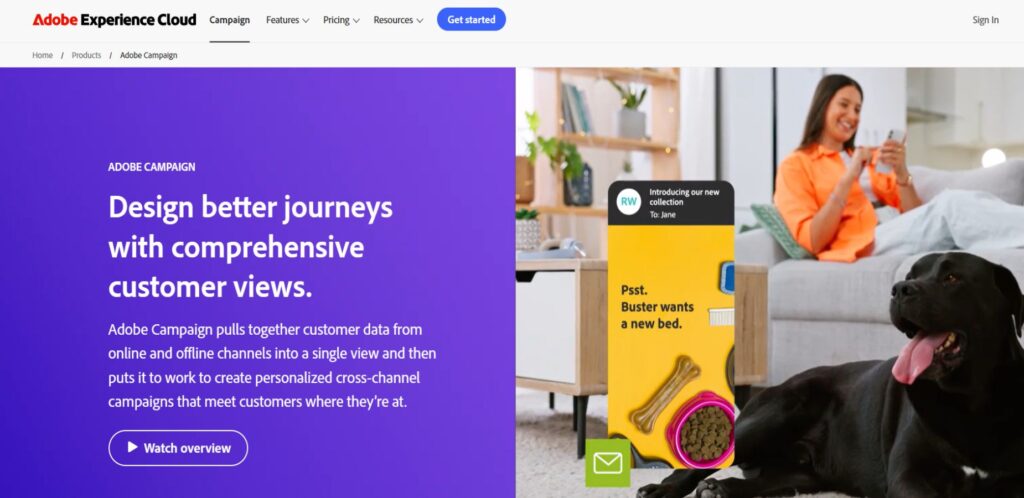
Adobe Campaign is a marketing automation platform. It provides tools for the creation, management, and optimization of multi-channel campaigns of personalized marketing across the enterprise. Powerful tools will help to conduct email marketing, SMS, social media, or direct mail campaigns.
The platform allows businesses to target specific customer segments, automate workflows, and track campaign performance with detailed analytics. These features include dynamic content personalization, A/B testing, customer journey mapping, and others. While the platform provides extensive capabilities for enterprise-level marketing, its complexity and high pricing may be a barrier for smaller businesses looking for a simpler solution.
Features:
- Email marketing and automation.
- Multi-channel campaign management.
- Personalization and segmentation.
- Real-time customer journey mapping.
- Integration with other Adobe tools.
Pros:
- Excellent for cross-channel marketing.
- Strong personalization capabilities.
Cons:
- Expensive for small businesses.
- Can be complex to set up.
Website: https://www.adobe.com/marketing
12. Heap
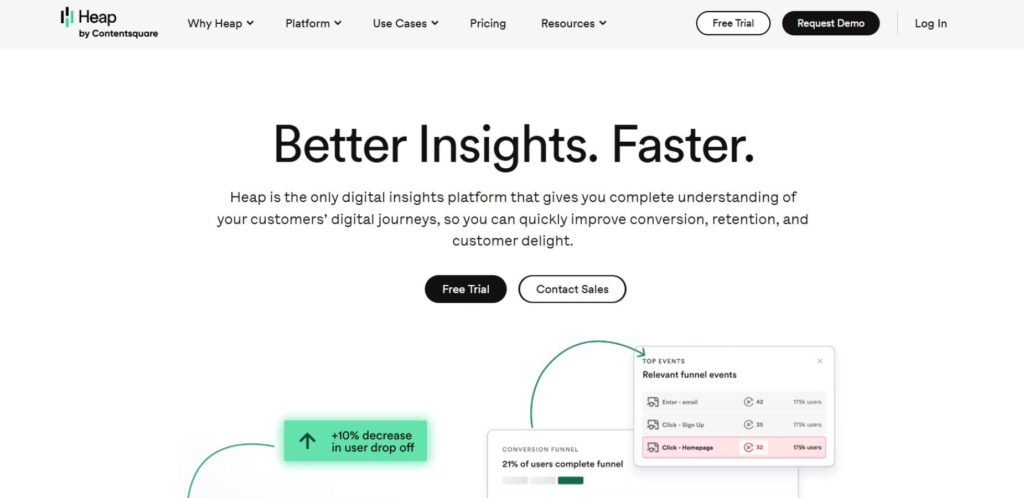
Heap gathers every user event that happens on your website or mobile app through its product analytics platform. By tracking every user interaction, Heap shows you detailed behavioral insights so you can review full customer paths effortlessly. Users gain real-time usage statistics from their products plus visual tools to study user flows while they develop profiles of groups and monitor events through built-in tracking capabilities.
Organizations benefit from using Heap because it records website user actions automatically and offers an intuitive setup that helps companies make their websites easy to use and boost conversions. Despite advanced analytics, the platform takes time to learn and its fees are too expensive for smaller companies.
Features:
- Automatic event tracking.
- Real-time analytics and insights.
- Funnel and cohort analysis.
- Customizable reports and dashboards.
- User behavior tracking across devices.
Pros:
- No need for manual event tracking.
- User-friendly interface.
Cons:
- Pricing may not suit small businesses.
- Limited data visualization options compared to other platforms.
Website: https://heap.io
13. HubSpot
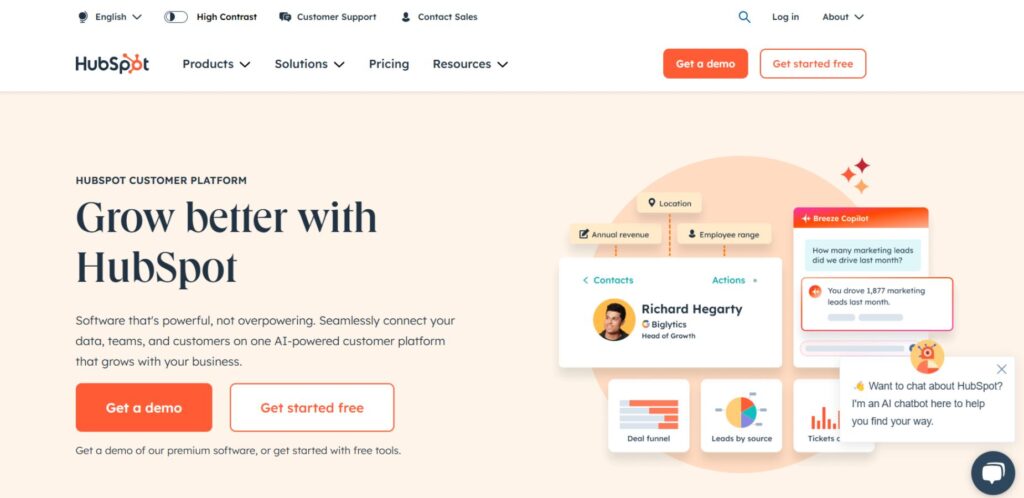
HubSpot provides one solution that unites inbound marketing, sales, and customer care to help businesses gain new customers and keep them satisfied. HubSpot enables businesses to use multiple tools for CRM, marketing automation, content management, email marketing, social media management, and lead generation through its content marketing strategies.
HubSpot lets companies simplify operations, monitor customer interactions, and sync sales and marketing teams better. Companies at every scale benefit from the platform’s easy-to-use design and flexible solutions. Despite having a free plan the advanced tools of Zoho CRM require significant financial investment from small companies.
Features:
- CRM and contact management.
- Email marketing automation.
- Content management and landing pages.
- Lead generation and nurturing tools.
- Reporting and analytics.
Pros:
- All-in-one inbound marketing platform.
- Easy to use and beginner-friendly.
Cons:
- Can become expensive as your business grows.
- Limited customization in lower-tier plans.
Website: https://www.hubspot.com
14. InMoment
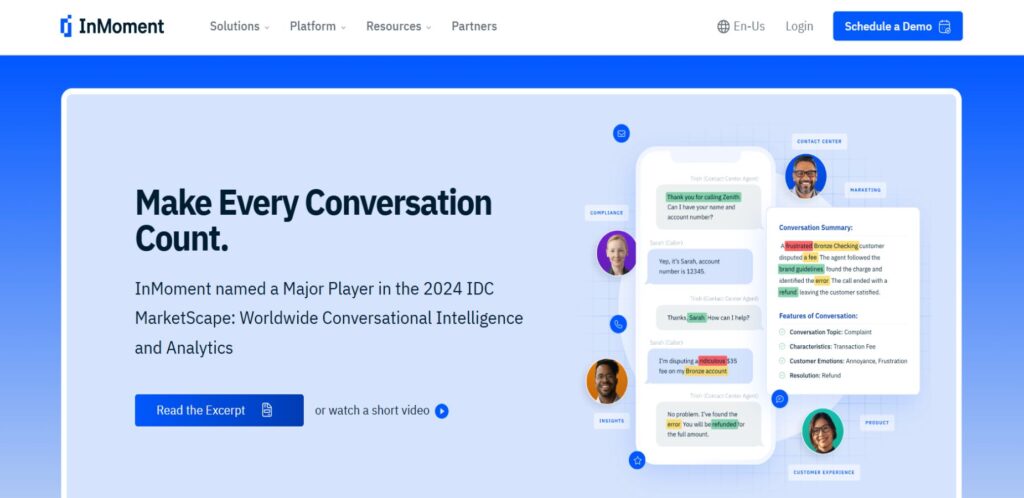
InMoment develops technology that lets businesses gather and understand customer opinions from all interaction platforms. Through its survey analysis tools and social media tracking the platform helps companies boost customer connection and retention. InMoment uses the latest reporting and analytics technology plus customer journey modeling to process segmented data.
The platform supports businesses in making their operations more valuable to customers and expands services that boost their business development. The platform has expensive prices for small companies and new users find its complicated advanced tools hard to learn.
Features:
- Real-time customer feedback analysis.
- Sentiment and trend tracking.
- Customizable surveys and reports.
- Multi-channel feedback collection.
- Employee and customer engagement tools.
Pros:
- Comprehensive feedback management.
- Real-time sentiment analysis.
Cons:
- Limited advanced analytics for larger enterprises.
- Can be expensive for smaller businesses.
Website: https://www.inmoment.com
15. Insider
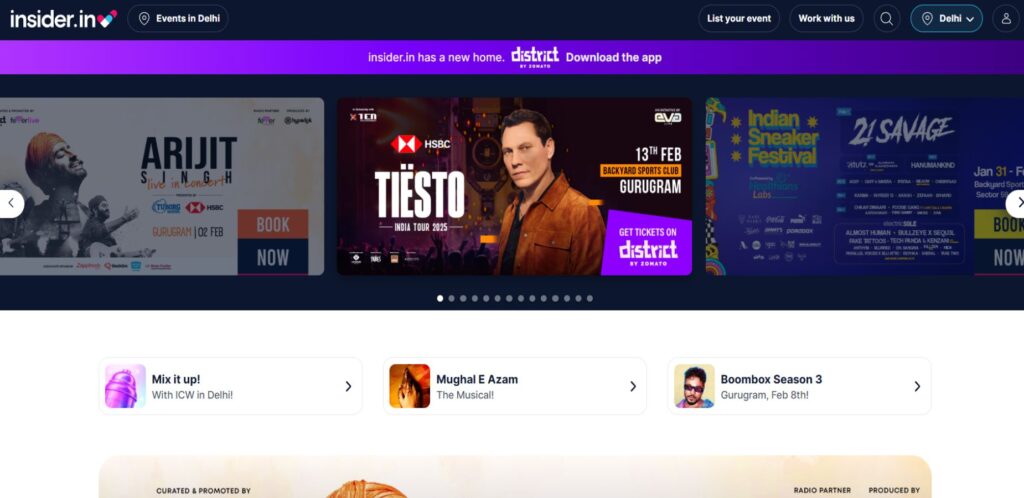
Insider delivers personalized digital experiences through its platform across digital channels including website apps and email. The system applies machine learning and AI to build unique customer pathways while enabling automatic operations and precise market departures. The platform offers services such as customer customization, targeted marketing, testing options, predictive tools, and integrated campaign functions.
Insider helps businesses raise their sales results and keep users engaged through data-based suggestions that optimize customer experiences. Business leaders may find it difficult to adapt to this solution’s advanced features while smaller businesses will face expensive pricing.
Features:
- Real-time personalization and targeting.
- Behavioral segmentation and journey mapping.
- Cross-channel marketing automation.
- A/B testing for optimized campaigns.
- Predictive analytics and reporting.
Pros:
- Powerful personalization features.
- Great for cross-channel campaigns.
Cons:
- Pricing may be high for small businesses.
- Complex for new users.
Website: https://www.useinsider.com
Top Features to Look for in Customer Analytics Software
A buyer should look for these core system capabilities when choosing customer analytics tools
- Real-Time Data Analytics: Our system provides instant customer activity updates at the present moment.
- Customer Segmentation: Group your customers based on their preferences and background elements to plan marketing efforts for specific groups.
- Predictive Analytics: Our system uses artificial intelligence and machine learning techniques to analyze markets, predict client behavior, and watch for leaving customer signs.
- Journey Mapping: Use a single map to show how customers move between all channels and improve their journey.
- Integration Capabilities: All business apps should share customer information with marketing data and CRM systems to offer full customer visibility.
- Behavioral Insights: The system records how users engage with your product to show you what activities customers will perform next.
- Customizable Dashboards: Let users create their monitors that show key business information they need to check.
- Cross-Channel Analytics: Look at how your customers interact through all channels you use online and offline.
- Sentiment Analysis: Watch your customer base to see how they interact with online platforms and social sites.
Conclusion
The power of customer analytics tools helps businesses study their customers fully while achieving growth. Analysis of customer data helps businesses make personalized offerings that keep users engaged while improving performance outcomes. These tools help teams base decisions on facts and make their work more effective while showing solid performance.
Organizations use segmentation and prediction plus journey mapping to monitor future market demands and preserve their business position. Your choice of digital solution depends on how well it fits your business growth plans and can integrate with existing systems. Robust analytics software becomes essential for businesses because customer expectations keep changing in today’s marketplace.
FAQs
1. What tools enable businesses to study and evaluate customer data?
Customer analytics tools let businesses measure and process customer information to see how people behave and what they want at different times. The system reveals useful information that lets us build unique customer contacts and protect our customers while making smart business choices.
2. How does my company improve with customer analytics tools?
The system lets us separate our customers based on their traits while forecasting their actions and identifying areas to improve our marketing effects and support better clients. These improvements boost business income and client contentment.
3. Which important features should customer analytics software include?
Search for software tools that monitor real-time information alongside segmentation features plus predictive modeling to combine with diverse systems and draw customer maps while allowing dashboard customization. A system’s ability to handle increased demands while protecting customer data according to regulations matters most.
4. Do small-scale businesses find customer analytics systems useful for their operations?
Small businesses find suitable customer analytics plans in the market to use their insights for winning over customers and growing their business without major resource requirements.
5. What measures should I put in place to protect my customer data during analytics tool use?
Pick software that follows laws about privacy protection and securely stores information while explaining what it does with that data. More tests plus employee education create better security procedures.
